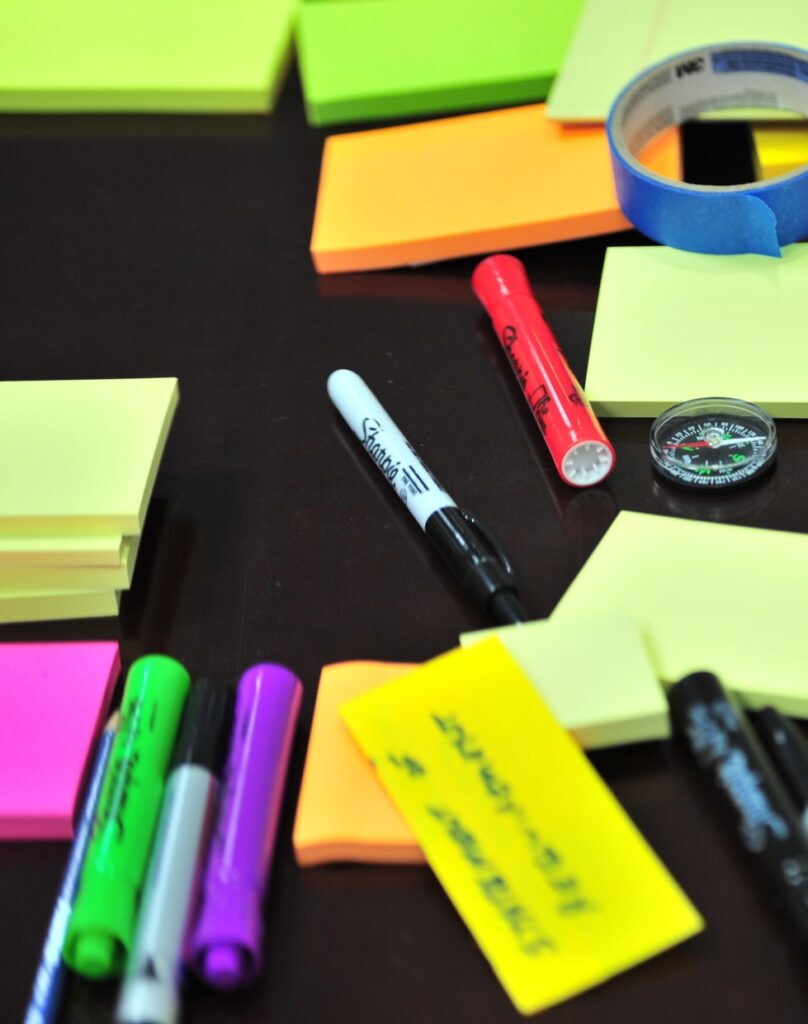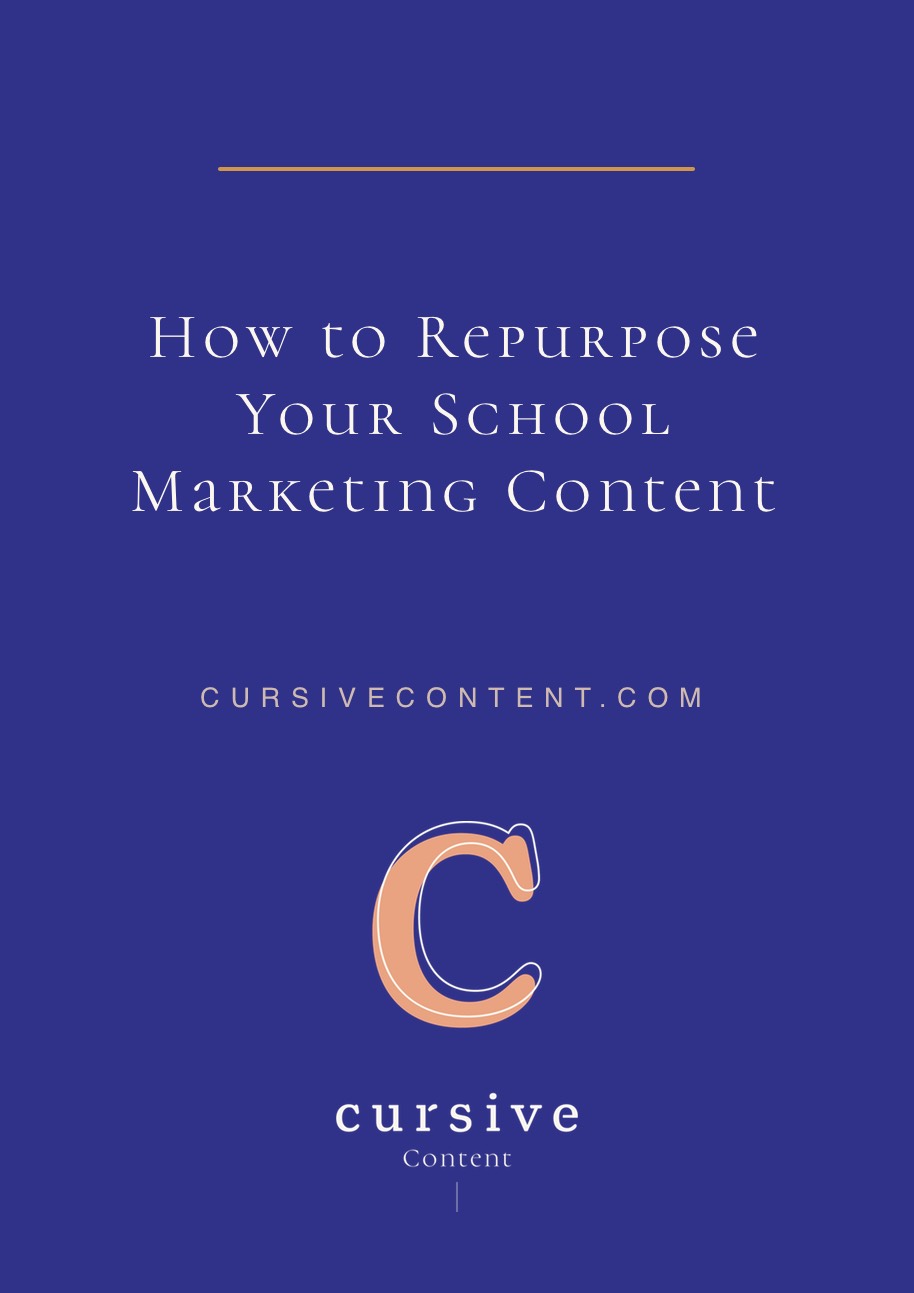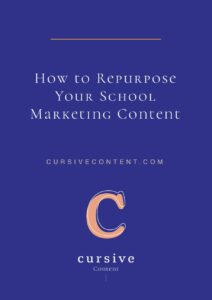How to Repurpose Your School Marketing Content

Do you use the power of content repurposing and make it part of your routine?
Content repurposing helps you deliver more content on more platforms to reach more of your audience—and as a result, it makes your job so much easier.
Here’s how to make it a part of your school marketing approach.
WHAT IS CONTENT REPURPOSING?
Here’s our favorite definition, via Search Engine Land:
“Repurposing content […] is repacking one piece of content across many different media. Each time, you’re adding to it (or taking away from it), and making it unique for the source, the medium and the user who’ll be reading it.”
When you have content repurposing in mind, you can do more with what you already have. You don’t always have to create something new.
Why does this matter?
Because developing new topics and creating new content can be hard, time consuming, even expensive.
Here at Cursive, we plan our editorial calendar for the upcoming year all at once, at the end of the preceding year. We’re flexible and deviate from it occasionally, but the calendar is our go-to plan. It aligns with events where we’re speaking, new content offerings we’re releasing and topics you’ve told us you want to know about.
Still, we have to sit down at our keyboards and write that content. And even though we love writing and storytelling and school marketing, creating content poses challenges.
Whether it’s finding the time, choosing the right angle or even just searching for the perfect blog post image, writing good content is rarely “easy”.
Sometimes, we all need a break from content creation.
WHY IS CONTENT REPURPOSING HELPFUL?
Content repurposing allows you to get more out of the work you have already done.
Wouldn’t you feel so much better about the effort you put in to your content creation if you knew you could use it to create even more outstanding content? That’s what content repurposing is all about.
Now, not to ruin your plans of kicking your heels up and starting an afternoon siesta ritual, but content repurposing does take time and effort. There are no robots doing the work for you. Still, repurposing makes it easier to create more content.
How?
Through content repurposing, you can use one foundational piece of content to create new content for various platforms, in different formats and directed toward difference audiences.
HOW CAN SCHOOL MARKETERS USE CONTENT REPURPOSING?
Let’s take a look at content repurposing’s definition again:
“Repurposing content […] is repacking one piece of content across many different media. Each time, you’re adding to it (or taking away from it), and making it unique for the source, the medium and the user who’ll be reading it.”
Now let’s dissect it and make it actionable:
“Repacking one piece of content” means that before you can repurpose, you have to find a place to start.
Gather all of your content: blog posts, press releases, brochures, alumni magazines—every piece of audience-facing communications you can find.
Start by reviewing it all. Set aside anything that is so out-of-date that it doesn’t make a good starting point for a new piece of content (you can always add those items to another, to-be-update pile for future perusal).
Now, look at all of that great content and think about how you can…
Repurpose your content to be unique for the source
In other words, let’s consider how you can revise the content to make it work better on a platform other than the one it was intended for.
For example, a press release about your new program might be full of great information, but you can’t just post it word-for-word on Instagram and expect results. Instead, you can pull a really great fact and an impactful photograph, to create an Instagram image and caption that will catch your audience’s eye. You can then direct them to your website to learn more. And if your press release can be an Instagram post, what else can it be?
Repurpose your content to be unique for the medium
Here, we want to think about the format of the original piece, and how it can be given new life in another format.
Let’s stick with the example of the press release. Let’s assume it’s a fairly detailed report, something that contains a lot of valuable information but isn’t a quick read. Can you distill the press release down to a paragraph? Can you take the most impressive information and use it to create an infographic that can be shared on social media? Revisions to the format often require the most work, but not nearly as much work as starting from scratch.
Repurpose your content to be unique for the user
In other words, think about who the original intended audience was, and how modifications can better fit the needs of another segment of your audience.
Going back to our information-packed press release, let’s say it was originally intended for the media—but you think it will impress alumni and prospective families, too. Can you change some of the wording to showcase how your school is putting alumni donations to work in meaningful ways, and make different edits to showcase the new and exciting advancements that are happening on campus that will intrigue prospective students? This turns the press release from a potentially dry and irrelevant document into something that’s more captivating and meaningful to each audience.
Now that we’ve broken down the definition piece-by-piece, though, we have to put it all back together.
Source, medium and user are not separate considerations– and neither are individual pieces of content
Any time you’re creating a plan for content repurposing, you should be considering source, medium and user but you shouldn’t silo them from each other.
If you start by considering the user, you should then consider source and medium within the context of that user. If you are looking at a new source for that content, first make sure it’s a place your audience already is, then choose a medium that aligns with that platform. If you’ve thought of a great new medium, make sure you have a platform for that medium and an audience who spends time there.
There are no limitations to repurposing, so brainstorm all the different combinations of source, medium and user that can work for that one foundational piece of content. You might be surprised how many ways there are to rework it.
While you’re doing that, also consider how you can combine multiple pieces of content to create one larger piece of content, as well as how you can segment large pieces of content to create shorter pieces of content.
This is why content repurposing isn’t quite that content vacation—it takes a fair amount of consideration to get started. But it allows you to use your creativity in different ways, and once it becomes part of your school’s approach to content, it doesn’t feel overwhelming—it feels smart.
MAKE A PLAN FOR REPURPOSING
Once you’ve thought through each piece of existing content and the best ways to repurpose, create a plan. You might create a group Google Doc, for example, that will stop your team from barraging each other with those “I have an idea!” emails.
Find a way that works for your school, and make sure to keep track of each idea. When you write new pieces of content, make sure that the next step after each piece is published is to brainstorm how it can be reused.
As with everything in school marketing, you have the ability to be agile, so pay attention to how your repurposed content is performing and learn from your successes and failures. Overall, content repurposing can make it easier to create a wide array of content for all of your audiences, and for schools, that can mean the difference between status quo and raging success.
MORE ARTICLES
-
 Clarity in 50 Words or Less: How to Write Your School’s One-Sentence Story
Clarity in 50 Words or Less: How to Write Your School’s One-Sentence Story -
 What Should Your School Do with Its Blog Now That AI Is Changing Search?
What Should Your School Do with Its Blog Now That AI Is Changing Search? -
 What Is Your Private School’s Bold & Unifying Big Promise?
What Is Your Private School’s Bold & Unifying Big Promise? -
 AI Writing Prompts to Power Private School Storytelling
AI Writing Prompts to Power Private School Storytelling -
 When to Outsource Your Private School Content Marketing to an Expert
When to Outsource Your Private School Content Marketing to an Expert -
 3 Unique Ways to Attract Dream Families with Content
3 Unique Ways to Attract Dream Families with Content -
 4 Quick & Easy Ways to Improve Your School’s Emails
4 Quick & Easy Ways to Improve Your School’s Emails -
 The Best Content Marketing Resources for Independent Schools
The Best Content Marketing Resources for Independent Schools

